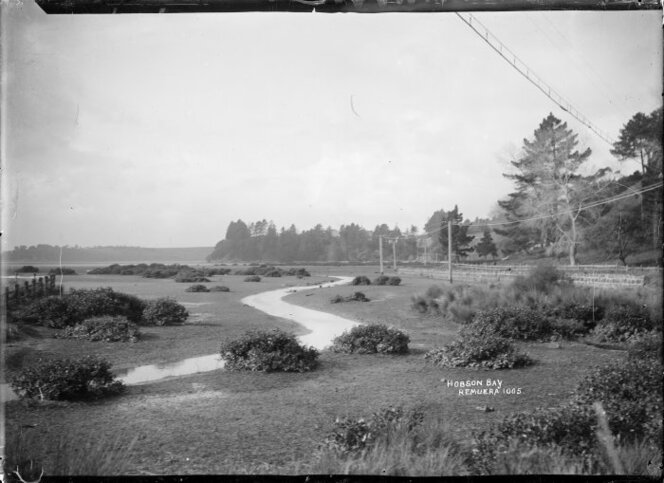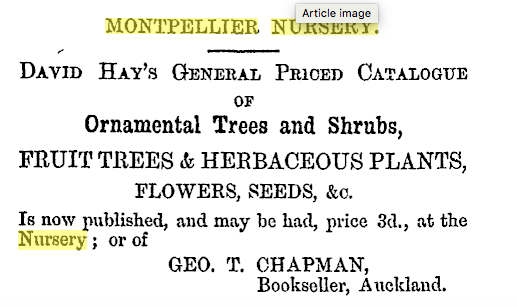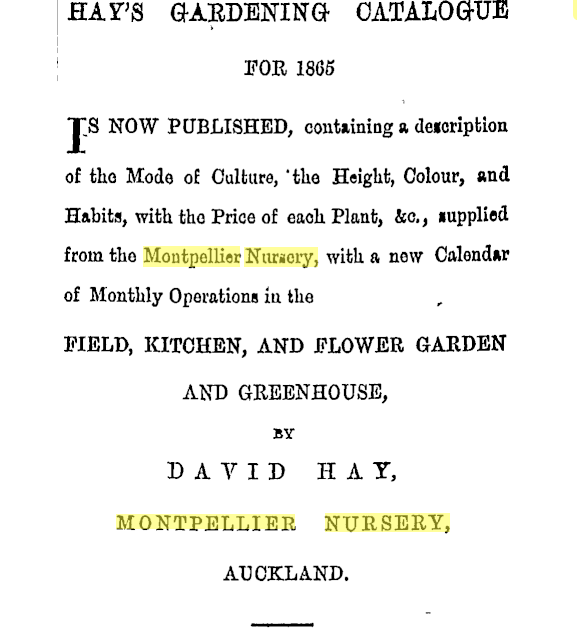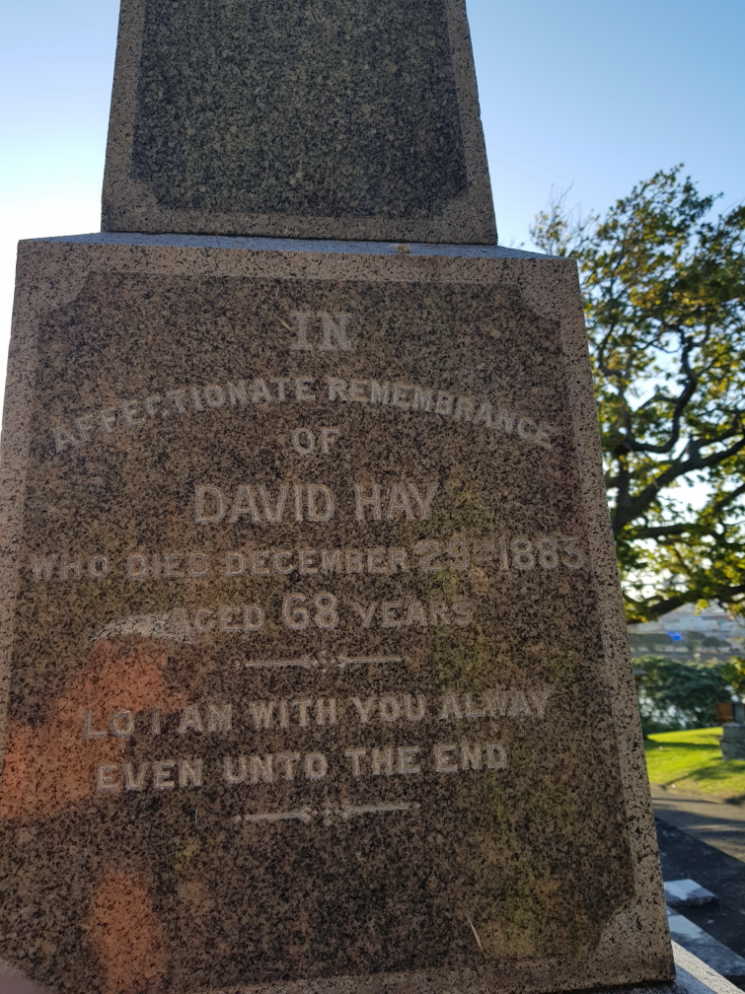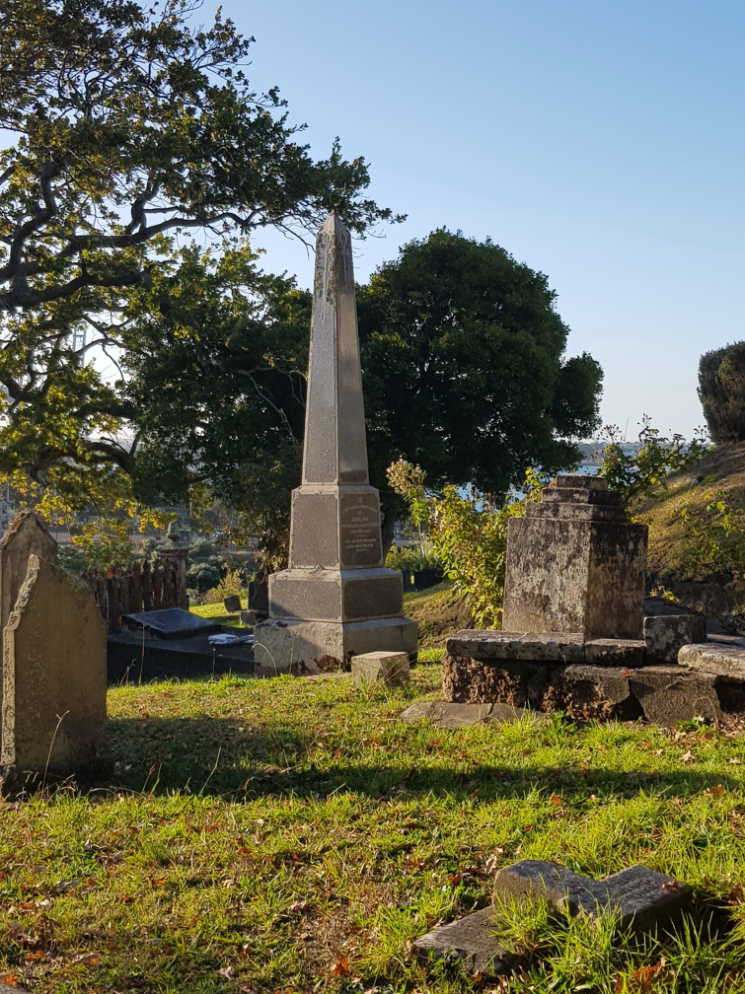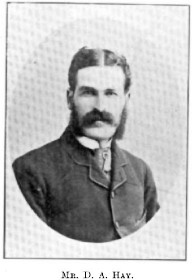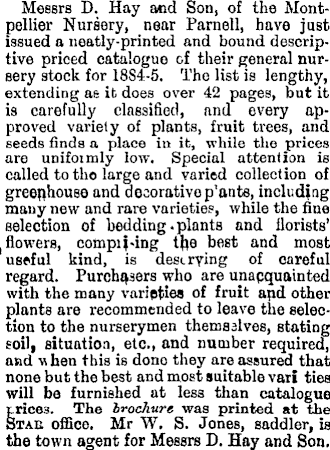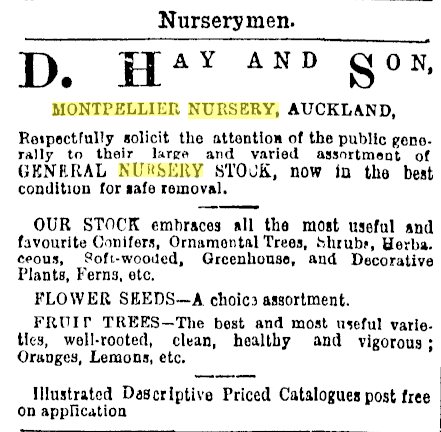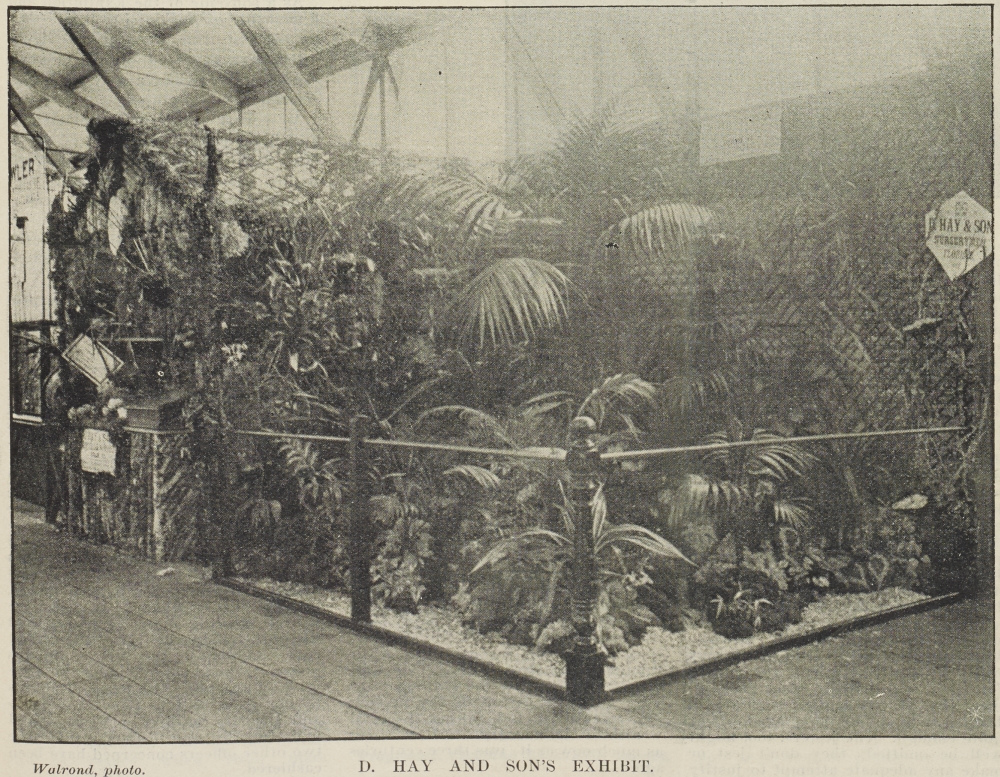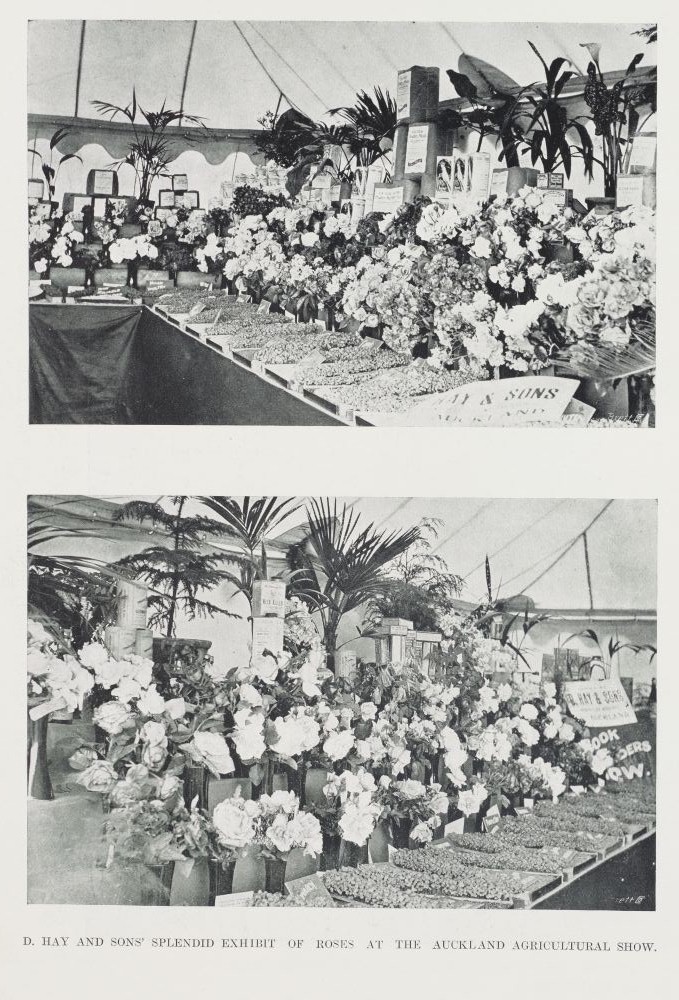David Hay and Son of Montpellier Nursery
The rich loamy soils and close proximity to some of Auckland’s wealthiest citizens meant that Remuera was an ideal site for commercial gardeners. [1]
By the early 1860s Remuera was the home of David Hay (1815-1883) and Charles Thomas Wren (1833-1901), two of New Zealand’s foremost pioneering nurserymen. Both men had acquired their gardening expertise by working for grand estates in Britain, prior to coming to New Zealand to set up their own businesses.
C T Wren founded Mount Hobson Nursery around 1860, on the lower slopes of Mount Hobson, whilst David Hay established Montpellier Nursery at Hobson Bay in 1855. David Hay and Son of Montpellier Nursery became Auckland’s pre-eminent nurserymen in the years 1855 to 1933.
David Hay was born at Rhynd, Perthshire, Scotland, on 2 October 1815. David is said to have trained as a gardener on an estate in Perthshire. A three-year apprenticeship began at the age of 12, and the boys learnt gardening during the day and at night studied subjects ranging from grammar and arithmetic to geometry, surveying, botany, garden architecture and geography. Further experience could be gained by moving from estate to estate. On 15 June 1840, in London, Hay married Sarah Baker (1813-1903). They subsequently lived in northern Hertfordshire and in Gloucestershire. [2]
In 1855 Hay, following his brother, emigrated to Auckland, with Sarah and their six children. Their last child was born in Auckland in March 1856.
David Hay acquired upwards of 40 acres at Hobson Bay. [2] He began operations on a waste piece of land at Hobson’s Bay (now the corner of Shore and Seaview Roads), which gave “promise of scant success” [3]. Six acres were deep alluvial soil and the remainder clay. He established the Montpellier Nursery on the best land and cows grazed the remainder. Despite his detractors David persevered and by 1867 Montpellier Nursery contained the “largest collection of plants, and flowers of any nursery in the North Island”. [3]
“..we..congratuate our esteemed fellow settler, Mr David Hay, upon the success which has attended his persevering and intelligent labours. When we consider that a quarter of a century ago the site of Auckland and its gardens was a dreary waste of tea-tree scrub, covering cold clay soil or jagged scoria layers, it is impossible for the most prejudiced of newcomers to withhold the meed of praise to those men who accomplished what we now see.” [3]
Montpellier was responsible for the introduction of many varieties of fruit trees, and their first advertisement appeared in the 1860 ‘Chapman’s New Zealand Almanac’, listing 17 items besides a large stock of fruit trees and flower and vegetable seeds. [2]
David Hay is credited with the first commercial introduction to New Zealand of Pinus radiata. In his 1860 catalogue only European conifers are mentioned, but from 1862 this began to change. It is likely that, initially, Hay’s radiata pine and other American conifer plants were imported from Shepherd and Company of Sydney, thought to have been the first Australian nursery to stock Pinus radiata. There is no evidence of a direct American link at this stage, but a price drop in the seeds advertised in Hay’s 1872 catalogue suggests that he was importing direct from America by this time, as were nurseries in other New Zealand centres. [2]
Hay compiled a manuscript on conifers and invited comments from Sir George Grey, who shared his interest.’The Pine Tree in New Zealand’, with additions by Grey, was first published in 1865 and by 1873 the book was into its third edition. In 1873 Hay exhibited cones of Pinus radiata in an address to the Auckland Institute. The release of large numbers of American conifers in this period was to change the New Zealand landscape permanently. [2]
The New Zealand Institute published articles by Hay, he wrote a monthly gardening column for the ‘Southern Monthly Magazine’, providing calendar details and guidance on the planting conditions in New Zealand. In 1862 Mr Hay issued his first priced catalogue, and thereafter Hay’s ‘Garden Book and Catalogue’ was issued annually by G. T. Chapman.
Besides writing, Hay served on the committee of the Auckland Horticultural Society, was a renowned exhibitor at floral and horticultural shows and in demand for judging at flower shows. [1, 2, 3]
The range of Hay’s nursery stock expanded, but limited transport meant that in the early years customers were mainly from the Auckland area. Montpellier by this time carried a comprehensive selection of plants and fulfilled orders from further afield. By 1879 David Hay had taken into partnership his only son, David Alexander (1853-1933). That year David Hay and Son took over the Victoria Nursery at Mechanics Bay. Many prominent nurserymen were trained at Montpellier.
David Hay died on 30 December 1883. He was not generally involved in public affairs, but was well regarded as an informed man of sound judgement. He was a prominent member of St Mary’s Church, Parnell, serving on its council for many years. His wife, Sarah Hay, died in 1903 at Montpellier Nursery. [2]
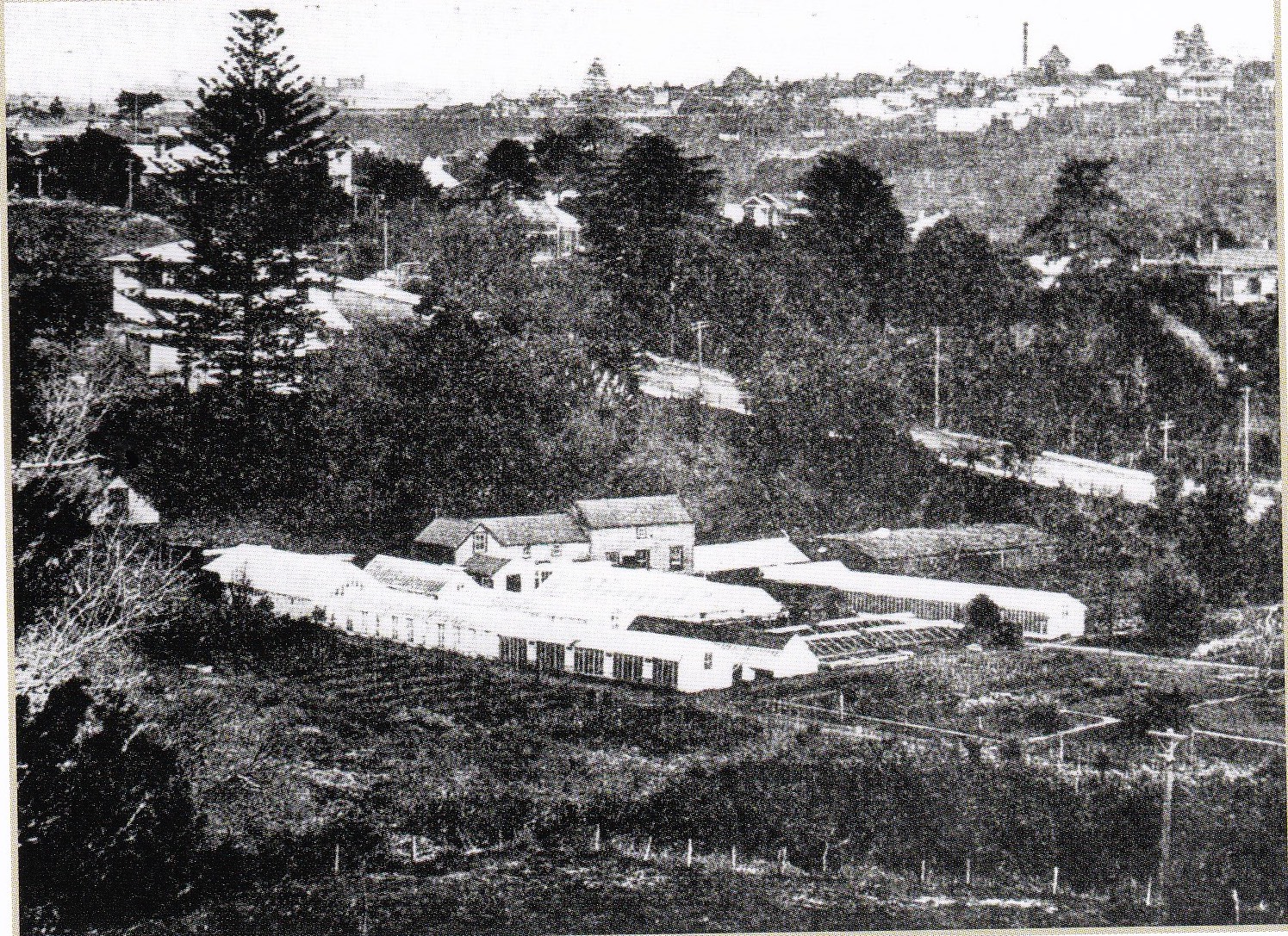
David Hay's nursery at Shore Road and the corner of Seaview Road, c. 1930. Carlyon & Morrow, page 310.
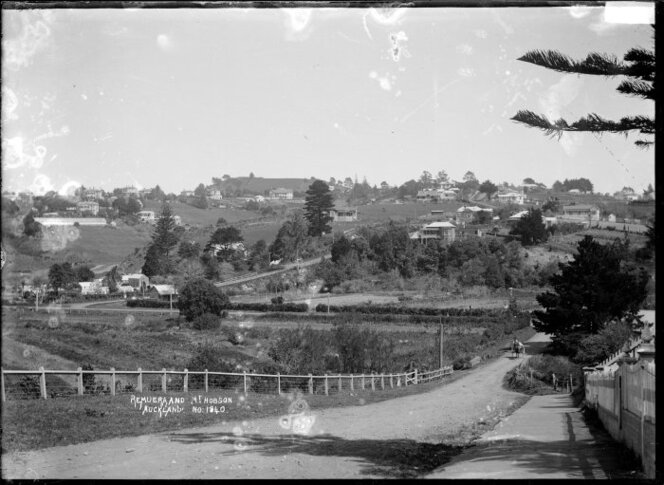
Shore Road is in the middle distance with Seaview Road running off it up the hill, Montpellier Nursery on corner, c.1910 (Alexander Turnbull Library, records, 22795624)

Shore Road running from bottom left with Seaview Road joining from the left, view of Montpellier Nursery on left, 1921 (Sir George Grey Special Collections, Auckland Libraries, 4-4567)

D Hay & Son, Descriptive catalogue 1899-1900, Montpellier Nursery,(Alexander Turnbull Library, 23029569)

D Hay & Son, Nurserymen,introducers of Burbank, Satsuma, and other Japanese plums. Clyman plum. Montpellier Nursery near Parnell, Auckland, N. Z. [Catalogue back cover]. 1899
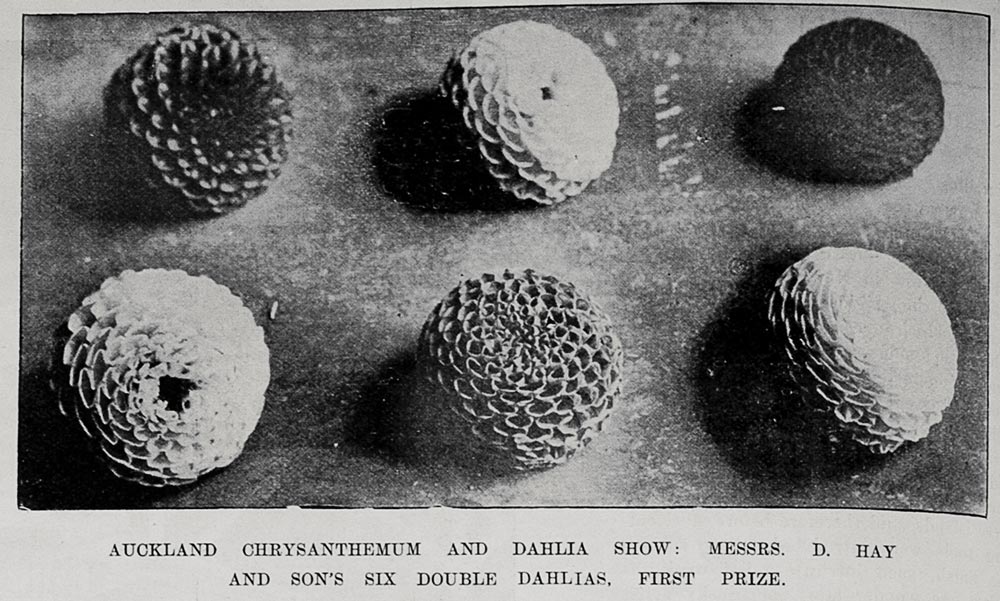
Auckland Chrysanthemum and Dahlia show. Messrs. D Hay and Son's six single Dahlias. First prize, 19 April 1901. (Auckland Libraries Heritage Collections AWNS-19010419-12-2)
After David Hay senior’s death, Montpellier continued under his son, David Alexander Hay.
David Alexander Hay was born in Gloucestershire, England, and arrived in Auckland with his parents in 1855. He was educated at the Church of England Grammar School in Parnell and joined his father in the business by 1879. [4]
D A Hay was a recognised authority on the nomenclature of plants and was a life member of the Auckland Horticultural Society. He held the National Diploma of Horticulture and was a foundation member, life member, vice president and a member of the Examining Board of the New Zealand Institute of Horticulture. He was also a foundation member, past president and life member of the New Zealand Horticultural Trades Association. [5]
He contributed articles on gardening subjects to the New Zealand Herald for many years. He took a keen and active interest in the early volunteer movement and he held a commission as lieutenant in the Gordon (Auckland) Rifle Volunteer Corps from 1887. He was an expert marksman and was a member of the team that won the Gordon Challenge Shield. For 50 years he was a vestryman of St. Mary’s Cathedral, Parnell. Mr. Hay’s marriage to Miss Elizabeth Emma Collins (c.1850-1949) took place in 1885. [5]
D A Hay added to the original Montpellier gardens, with a branch nursery of eleven acres near Orakei Road in Remuera. [1, 4] During his ownership the nursery reached its zenith, becoming widely known overseas as well as in New Zealand for quality and variety. Valuable plum varieties were introduced, including the Japanese plum, as well as the Burbank and Wickson plums, and many importations came from Europe, while other fruit varieties, such as the Goldmine nectarine and Golden Queen peach, were local in origin. [2]
Montpellier had an extensive customer list, including Robert Louis Stevenson, who was keen to acquire plants for his garden at Vailima, Samoa [1]. David Hay and Son continued producing catalogues and were prominent exhibitors. The 1903 catalogue advertised 2,500 plants. [1]
D A Hay took a prominent part in the horticultural shows held in Auckland, and his services as a judge were much sought by horticultural societies throughout the province. [5]
David Alexander Hay died in 1933, at his residence at Seaview Road. He is buried at Purewa Cemetery. He was survived by his wife, four daughters and a son and four grandchildren. His wife Elizabeth died in 1949. [5]
The nursery was leased for a few years after his death, but in effect, Montpellier died with him. [2]

